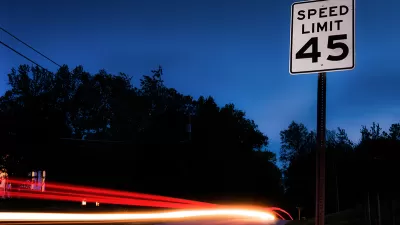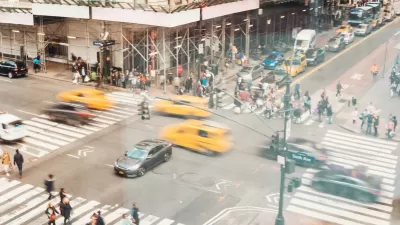Motor vehicle crashes claim over 30,000 lives per year, with related costs in the hundreds of billions. While we sometimes view that frightening statistic as inevitable, there are reasons to reexamine speed limits and how we set them.

In this article, Anna Maria Barry-Jester asks the question: where do speed limits come from? "Given the social and economic toll of speeding, one might assume that we set speed limits with careful calculations aimed at maximizing safety." However, she continues, "in most places, speed limits are largely determined by the speed most people feel safe traveling."
This average comfortable speed sits at a hypothetical 85th percentile: given the road, 85% of drivers will cruise below it and 15 percent will speed above it. But road engineers know this, and build margins of "safety" into new roads: "[the 85th percentile is] used to design a road to meet that speed at a minimum, with a factor of safety allowing for faster travel."
The article discusses a historical shift from keeping roads safe from cars, to keeping them safe for cars. "City speed limits were set below 20 mph until automakers and industry groups realized that such low limits were going to hurt sales. To change public opinion, campaigns were started to criminalize pedestrians in the road (jaywalking) and to shift the blame for accidents from cars to 'reckless drivers.'"
Nowadays, people are less willing to accept the auto-centric status quo, at least in cities. Recent efforts like New York's Vision Zero plan mark departures from our "culture of acceptance" around traffic fatalities.
FULL STORY: Why The Rules Of The Road Aren’t Enough To Prevent People From Dying

Alabama: Trump Terminates Settlements for Black Communities Harmed By Raw Sewage
Trump deemed the landmark civil rights agreement “illegal DEI and environmental justice policy.”

Planetizen Federal Action Tracker
A weekly monitor of how Trump’s orders and actions are impacting planners and planning in America.

The 120 Year Old Tiny Home Villages That Sheltered San Francisco’s Earthquake Refugees
More than a century ago, San Francisco mobilized to house thousands of residents displaced by the 1906 earthquake. Could their strategy offer a model for the present?

In Both Crashes and Crime, Public Transportation is Far Safer than Driving
Contrary to popular assumptions, public transportation has far lower crash and crime rates than automobile travel. For safer communities, improve and encourage transit travel.

Report: Zoning Reforms Should Complement Nashville’s Ambitious Transit Plan
Without reform, restrictive zoning codes will limit the impact of the city’s planned transit expansion and could exclude some of the residents who depend on transit the most.

Judge Orders Release of Frozen IRA, IIJA Funding
The decision is a victory for environmental groups who charged that freezing funds for critical infrastructure and disaster response programs caused “real and irreparable harm” to communities.
Urban Design for Planners 1: Software Tools
This six-course series explores essential urban design concepts using open source software and equips planners with the tools they need to participate fully in the urban design process.
Planning for Universal Design
Learn the tools for implementing Universal Design in planning regulations.
Clanton & Associates, Inc.
Jessamine County Fiscal Court
Institute for Housing and Urban Development Studies (IHS)
City of Grandview
Harvard GSD Executive Education
Toledo-Lucas County Plan Commissions
Salt Lake City
NYU Wagner Graduate School of Public Service





























